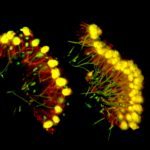Link to Pubmed [PMID] – 38441500
Link to HAL – hal-05083684
Link to DOI – 10.1242/jcs.261987
J Cell Sci 2024 Mar; 137(5):
In this Perspective, Journal of Cell Science invited researchers working on cell and tissue polarity to share their thoughts on unique, emerging or open questions relating to their field. The goal of this article is to feature ‘voices’ from scientists around the world and at various career stages, to bring attention to innovative and thought-provoking topics of interest to the cell biology community. These voices discuss intriguing questions that consider polarity across scales, evolution, development and disease. What can yeast and protists tell us about the evolution of cell and tissue polarity in animals? How are cell fate and development influenced by emerging dynamics in cell polarity? What can we learn from atypical and extreme polarity systems? How can we arrive at a more unified biophysical understanding of polarity? Taken together, these pieces demonstrate the broad relevance of the fascinating phenomenon of cell polarization to diverse fundamental biological questions.

